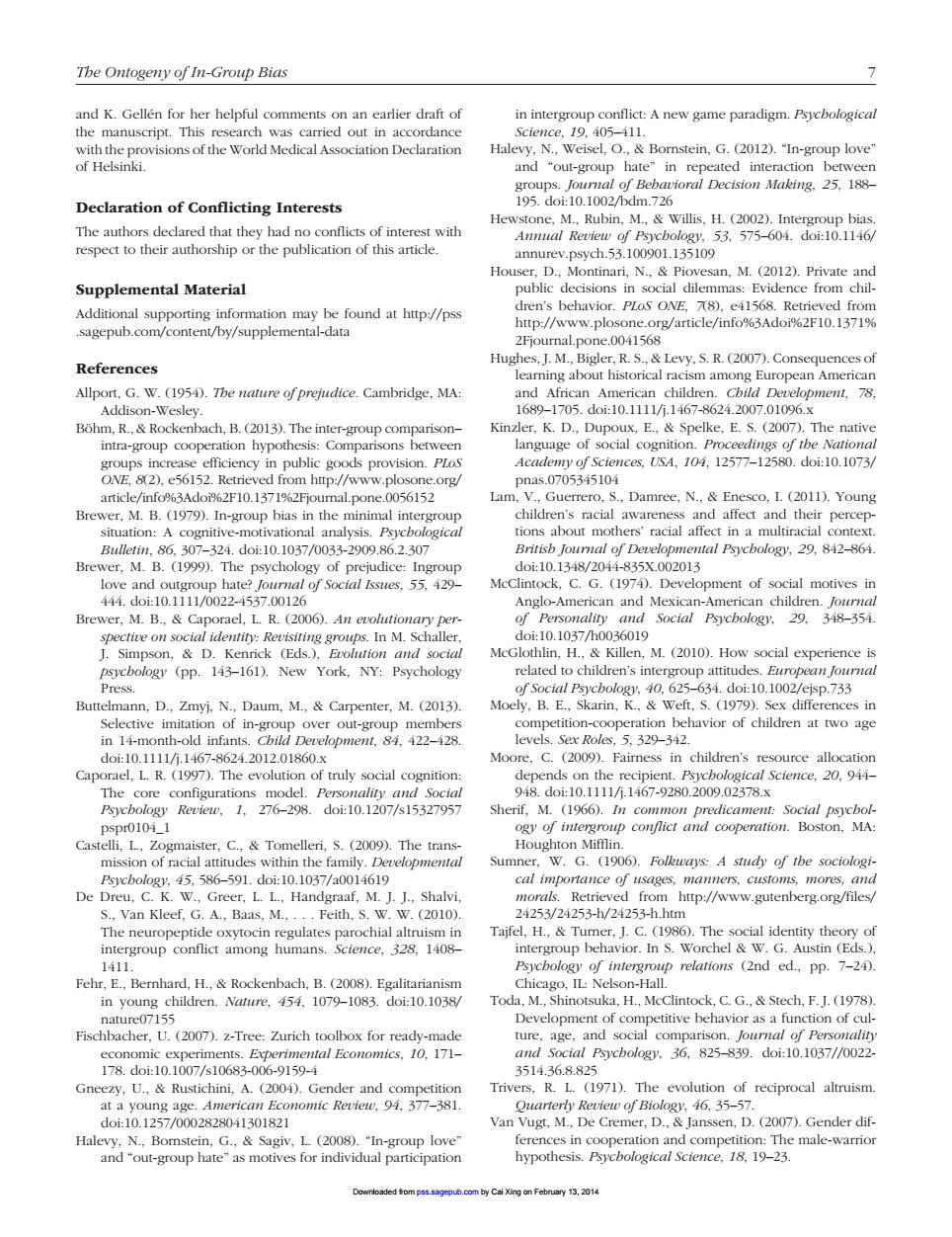正在加载图片...

The Onlogeny of mn-Group Bias 7 Halevy,N..Weisel,O.,&Bomnstein.G.(2012)."In-group love Declaration of Conflicting Interests m22o pych 3.10090113510 Supplemental Material ne0156 References Allport.G.W.(1954).Tbe nature of prefudice.Cambridge,MA: opment.78. pelke,E.S.(2 he nat intra-group coope Guerrero, 5..Damree,N..&Enesco,I.(2011).Young C.G.(197).Development of social motives ir 444. 2-4537001266An 29.348-35 M.Schaller. M.(2010.Ho Press. Daum.M.&Carpenter,M.(2013) Mo infant dp0LRa79i2200l0inyaocacoemtom childre nds on th 01041 C&.s.(200) 45586591.dot101057ao014619 cal imp De Dreu. Greer. tocin gulat Taifel.H..&Tumer..C.().The social idenrity theory of r.in los2ndcd.pp 1-20 M.Shin以on 35142682 d0t101257/0002823041301821 Van Cremer,D D.(2007).Gender duf e male-warrior y.204 The Ontogeny of In-Group Bias 7 and K. Gellén for her helpful comments on an earlier draft of the manuscript. This research was carried out in accordance with the provisions of the World Medical Association Declaration of Helsinki. Declaration of Conflicting Interests The authors declared that they had no conflicts of interest with respect to their authorship or the publication of this article. Supplemental Material Additional supporting information may be found at http://pss .sagepub.com/content/by/supplemental-data References Allport, G. W. (1954). The nature of prejudice. Cambridge, MA: Addison-Wesley. Böhm, R., & Rockenbach, B. (2013). The inter-group comparison– intra-group cooperation hypothesis: Comparisons between groups increase efficiency in public goods provision. PLoS ONE, 8(2), e56152. Retrieved from http://www.plosone.org/ article/info%3Adoi%2F10.1371%2Fjournal.pone.0056152 Brewer, M. B. (1979). In-group bias in the minimal intergroup situation: A cognitive-motivational analysis. Psychological Bulletin, 86, 307–324. doi:10.1037/0033-2909.86.2.307 Brewer, M. B. (1999). The psychology of prejudice: Ingroup love and outgroup hate? Journal of Social Issues, 55, 429– 444. doi:10.1111/0022-4537.00126 Brewer, M. B., & Caporael, L. R. (2006). An evolutionary perspective on social identity: Revisiting groups. In M. Schaller, J. Simpson, & D. Kenrick (Eds.), Evolution and social psychology (pp. 143–161). New York, NY: Psychology Press. Buttelmann, D., Zmyj, N., Daum, M., & Carpenter, M. (2013). Selective imitation of in-group over out-group members in 14-month-old infants. Child Development, 84, 422–428. doi:10.1111/j.1467-8624.2012.01860.x Caporael, L. R. (1997). The evolution of truly social cognition: The core configurations model. Personality and Social Psychology Review, 1, 276–298. doi:10.1207/s15327957 pspr0104_1 Castelli, L., Zogmaister, C., & Tomelleri, S. (2009). The transmission of racial attitudes within the family. Developmental Psychology, 45, 586–591. doi:10.1037/a0014619 De Dreu, C. K. W., Greer, L. L., Handgraaf, M. J. J., Shalvi, S., Van Kleef, G. A., Baas, M., . . . Feith, S. W. W. (2010). The neuropeptide oxytocin regulates parochial altruism in intergroup conflict among humans. Science, 328, 1408– 1411. Fehr, E., Bernhard, H., & Rockenbach, B. (2008). Egalitarianism in young children. Nature, 454, 1079–1083. doi:10.1038/ nature07155 Fischbacher, U. (2007). z-Tree: Zurich toolbox for ready-made economic experiments. Experimental Economics, 10, 171– 178. doi:10.1007/s10683-006-9159-4 Gneezy, U., & Rustichini, A. (2004). Gender and competition at a young age. American Economic Review, 94, 377–381. doi:10.1257/0002828041301821 Halevy, N., Bornstein, G., & Sagiv, L. (2008). “In-group love” and “out-group hate” as motives for individual participation in intergroup conflict: A new game paradigm. Psychological Science, 19, 405–411. Halevy, N., Weisel, O., & Bornstein, G. (2012). “In-group love” and “out-group hate” in repeated interaction between groups. Journal of Behavioral Decision Making, 25, 188– 195. doi:10.1002/bdm.726 Hewstone, M., Rubin, M., & Willis, H. (2002). Intergroup bias. Annual Review of Psychology, 53, 575–604. doi:10.1146/ annurev.psych.53.100901.135109 Houser, D., Montinari, N., & Piovesan, M. (2012). Private and public decisions in social dilemmas: Evidence from children’s behavior. PLoS ONE, 7(8), e41568. Retrieved from http://www.plosone.org/article/info%3Adoi%2F10.1371% 2Fjournal.pone.0041568 Hughes, J. M., Bigler, R. S., & Levy, S. R. (2007). Consequences of learning about historical racism among European American and African American children. Child Development, 78, 1689–1705. doi:10.1111/j.1467-8624.2007.01096.x Kinzler, K. D., Dupoux, E., & Spelke, E. S. (2007). The native language of social cognition. Proceedings of the National Academy of Sciences, USA, 104, 12577–12580. doi:10.1073/ pnas.0705345104 Lam, V., Guerrero, S., Damree, N., & Enesco, I. (2011). Young children’s racial awareness and affect and their perceptions about mothers’ racial affect in a multiracial context. British Journal of Developmental Psychology, 29, 842–864. doi:10.1348/2044-835X.002013 McClintock, C. G. (1974). Development of social motives in Anglo-American and Mexican-American children. Journal of Personality and Social Psychology, 29, 348–354. doi:10.1037/h0036019 McGlothlin, H., & Killen, M. (2010). How social experience is related to children’s intergroup attitudes. European Journal of Social Psychology, 40, 625–634. doi:10.1002/ejsp.733 Moely, B. E., Skarin, K., & Weft, S. (1979). Sex differences in competition-cooperation behavior of children at two age levels. Sex Roles, 5, 329–342. Moore, C. (2009). Fairness in children’s resource allocation depends on the recipient. Psychological Science, 20, 944– 948. doi:10.1111/j.1467-9280.2009.02378.x Sherif, M. (1966). In common predicament: Social psychology of intergroup conflict and cooperation. Boston, MA: Houghton Mifflin. Sumner, W. G. (1906). Folkways: A study of the sociological importance of usages, manners, customs, mores, and morals. Retrieved from http://www.gutenberg.org/files/ 24253/24253-h/24253-h.htm Tajfel, H., & Turner, J. C. (1986). The social identity theory of intergroup behavior. In S. Worchel & W. G. Austin (Eds.), Psychology of intergroup relations (2nd ed., pp. 7–24). Chicago, IL: Nelson-Hall. Toda, M., Shinotsuka, H., McClintock, C. G., & Stech, F. J. (1978). Development of competitive behavior as a function of culture, age, and social comparison. Journal of Personality and Social Psychology, 36, 825–839. doi:10.1037//0022- 3514.36.8.825 Trivers, R. L. (1971). The evolution of reciprocal altruism. Quarterly Review of Biology, 46, 35–57. Van Vugt, M., De Cremer, D., & Janssen, D. (2007). Gender differences in cooperation and competition: The male-warrior hypothesis. Psychological Science, 18, 19–23. Downloaded from pss.sagepub.com by Cai Xing on February 13, 2014